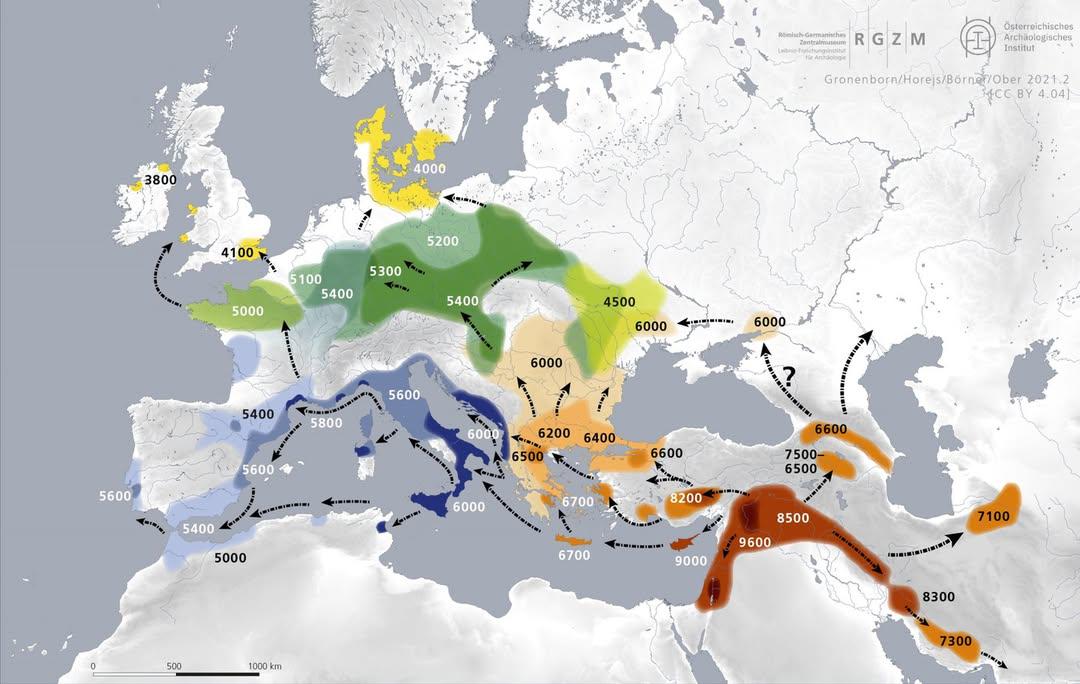Map of Early Farming Spread in Europe (9000-3800 BC)


David Chen
Data Visualization Specialist
David Chen is an expert in transforming complex geographic datasets into compelling visual narratives. He combines his background in computer science ...
Geographic Analysis
What This Map Shows
The map titled 'How Early Farming Spread into Europe from 9000 to 3800 BC' illustrates the gradual diffusion of agricultural practices across Europe, tracing the routes taken by early farmers as they migrated from their origins in the Near East. The visualization highlights key regions where farming techniques took root, demonstrating the transformative impact of agriculture on the landscape and societies of ancient Europe. By pinpointing the spread of farming, this map provides a visual representation of a pivotal shift in human history, marking the transition from hunter-gatherer lifestyles to settled agricultural communities.
Deep Dive into Early Farming and Its Spread
The emergence of farming around 9000 BC is one of the most significant developments in human history. Initially, this shift began in the Fertile Crescent, an area spanning parts of modern-day Turkey, Syria, Lebanon, Israel, and Iraq. The domestication of plants like wheat and barley, alongside animals such as sheep and goats, set the stage for a revolution in how humans interacted with their environment. This transition from nomadic lifestyles to agriculture allowed for the establishment of permanent settlements, leading to population growth and the development of complex societies.
Interestingly, as these early farmers migrated into Europe, they brought with them not only agricultural techniques but also cultural practices and social structures. The map highlights various migration routes taken by these groups, often following river valleys and other natural corridors that facilitated their movement. For instance, the Danube River, flowing through Central and Eastern Europe, served as a vital artery for the spread of farming communities, enabling the exchange of ideas, seeds, and livestock between regions.
It's essential to recognize that the spread of agriculture was not uniform. Different regions adopted farming at varying rates, influenced by local climates, soil conditions, and existing hunter-gatherer populations. In southern Europe, for example, the Mediterranean climate supported the cultivation of olives and grapes, while Northern Europe presented challenges due to harsher climates and less arable land, leading to a slower adoption of farming practices in some areas.
As farming techniques advanced, so did the societal structures of these communities. The establishment of agricultural practices laid the groundwork for trade, specialization of labor, and the eventual rise of cities. By around 3800 BC, many parts of Europe had transitioned significantly from foraging to farming, marking the dawn of the Neolithic era in these regions. This period saw the construction of megalithic structures, communal living, and the beginnings of social stratification, as some individuals began to accumulate more resources than others.
Regional Analysis
The map illustrates a fascinating mosaic of early agricultural adoption across Europe. In the southern regions, particularly in areas like present-day Greece and Italy, the adoption of farming occurred relatively quickly. Here, the Mediterranean climate was conducive to growing a variety of crops, leading to early urban developments like Çatalhöyük in Anatolia, which became a hub for trade and cultural exchange.
Conversely, in northern regions such as Scandinavia and parts of the British Isles, the adoption of farming was more gradual. The harsher climates and shorter growing seasons meant that many communities initially relied on a combination of agriculture and traditional hunting-gathering. Interestingly, archaeological evidence suggests that while these northern communities eventually adopted farming, they often retained many aspects of their traditional lifestyles longer than their southern counterparts.
In Central Europe, particularly along the banks of the Rhine and Danube Rivers, the influx of farmers from the south facilitated the integration of agricultural practices into existing hunter-gatherer societies. The resulting cultural exchange led to a blend of farming techniques and local traditions, fostering a unique agricultural landscape that would shape Europe for millennia.
Significance and Impact
Understanding the spread of early farming in Europe is crucial for grasping the foundations of modern European societies. The transition from foraging to agriculture not only transformed economies but also fundamentally altered social structures, leading to the rise of cities and complex civilizations. This historical shift has long-lasting implications, as the patterns established during this time continue to influence agricultural practices and land use today.
What's fascinating is that this map serves as a reminder of the interconnectedness of human cultures. The migration of early farmers highlights how knowledge and innovations can spread across vast distances, shaping the development of entire regions. As we look to the future, studying these early agricultural movements can provide insights into current trends in food security, sustainability, and the ongoing relationship between humans and their environment. With the challenges of climate change and population growth, understanding our agricultural past may offer valuable lessons for navigating the complexities of the modern world.
Visualization Details
- Published
- October 30, 2025
- Views
- 8
Comments
Loading comments...